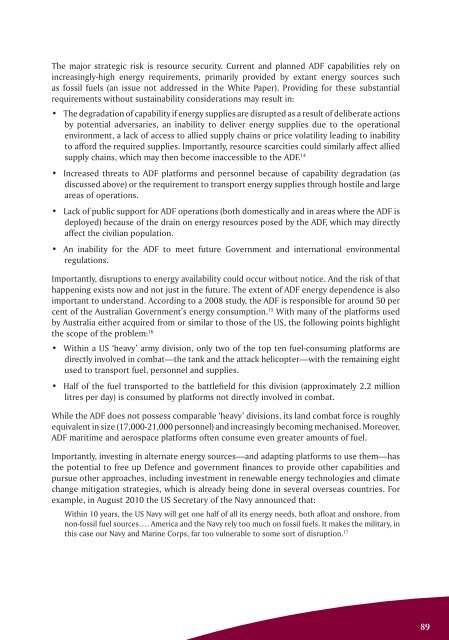ISSUE 183 : Nov/Dec - 2010 - Australian Defence Force Journal
ISSUE 183 : Nov/Dec - 2010 - Australian Defence Force Journal
ISSUE 183 : Nov/Dec - 2010 - Australian Defence Force Journal
Create successful ePaper yourself
Turn your PDF publications into a flip-book with our unique Google optimized e-Paper software.
The major strategic risk is resource security. Current and planned ADF capabilities rely onincreasingly-high energy requirements, primarily provided by extant energy sources suchas fossil fuels (an issue not addressed in the White Paper). Providing for these substantialrequirements without sustainability considerations may result in:• The degradation of capability if energy supplies are disrupted as a result of deliberate actionsby potential adversaries, an inability to deliver energy supplies due to the operationalenvironment, a lack of access to allied supply chains or price volatility leading to inabilityto afford the required supplies. Importantly, resource scarcities could similarly affect alliedsupply chains, which may then become inaccessible to the ADF. 14• Increased threats to ADF platforms and personnel because of capability degradation (asdiscussed above) or the requirement to transport energy supplies through hostile and largeareas of operations.• Lack of public support for ADF operations (both domestically and in areas where the ADF isdeployed) because of the drain on energy resources posed by the ADF, which may directlyaffect the civilian population.• An inability for the ADF to meet future Government and international environmentalregulations.Importantly, disruptions to energy availability could occur without notice. And the risk of thathappening exists now and not just in the future. The extent of ADF energy dependence is alsoimportant to understand. According to a 2008 study, the ADF is responsible for around 50 percent of the <strong>Australian</strong> Government’s energy consumption. 15 With many of the platforms usedby Australia either acquired from or similar to those of the US, the following points highlightthe scope of the problem: 16• Within a US ‘heavy’ army division, only two of the top ten fuel-consuming platforms aredirectly involved in combat—the tank and the attack helicopter—with the remaining eightused to transport fuel, personnel and supplies.• Half of the fuel transported to the battlefield for this division (approximately 2.2 millionlitres per day) is consumed by platforms not directly involved in combat.While the ADF does not possess comparable ‘heavy’ divisions, its land combat force is roughlyequivalent in size (17,000-21,000 personnel) and increasingly becoming mechanised. Moreover,ADF maritime and aerospace platforms often consume even greater amounts of fuel.Importantly, investing in alternate energy sources—and adapting platforms to use them—hasthe potential to free up <strong>Defence</strong> and government finances to provide other capabilities andpursue other approaches, including investment in renewable energy technologies and climatechange mitigation strategies, which is already being done in several overseas countries. Forexample, in August <strong>2010</strong> the US Secretary of the Navy announced that:Within 10 years, the US Navy will get one half of all its energy needs, both afloat and onshore, fromnon-fossil fuel sources…. America and the Navy rely too much on fossil fuels. It makes the military, inthis case our Navy and Marine Corps, far too vulnerable to some sort of disruption. 1789
















